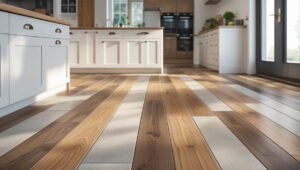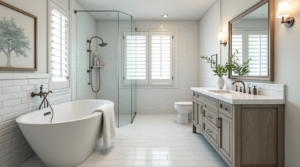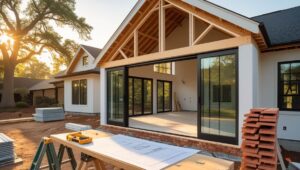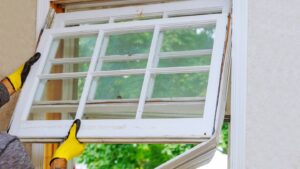As more homeowners choose to age in place, the demand for safe, stylish, and functional bathroom renovations continues to grow. A well-designed bathroom can significantly improve safety, comfort, and independence for seniors and individuals with mobility challenges. Universal bathroom design is not just about compliance with accessibility standards—it’s about creating a space that works for everyone, regardless of age or ability.
At Double T Construction & Roofing, we specialize in aging-in-place bathroom design and remodeling, offering tailored solutions that blend safety with modern aesthetics. In this article, we’ll explore practical and innovative strategies to guide you through a senior-friendly bathroom renovation, focusing on long-term usability and comfort.
Understanding Aging-in-Place Bathroom Design
Aging in place refers to the ability to live in one’s own home safely, independently, and comfortably as aging occurs. A key component of this lifestyle is the bathroom—a space where slips, falls, and other accidents are most common. Aging-in-place bathroom design prioritizes accessibility, safety, and ease of use, all while maintaining the elegance and style of a modern renovation.
Universal bathroom design is central to aging-in-place remodeling. This design philosophy ensures that the space is usable by people of all ages and physical abilities without needing major future modifications. Whether you’re planning for yourself or a loved one, integrating universal design from the start can save time, money, and stress down the road.
Designing for Accessibility Without Compromising Style
Accessibility does not mean you have to sacrifice style. In fact, with today’s wide variety of materials and products, a bathroom can be both elegant and functional. Universal design features such as wider doorways, walk-in showers, and strategic lighting can be seamlessly integrated into any bathroom aesthetic—from traditional to contemporary.
Aging in place bathroom renovations often involve lowering countertop heights, ensuring adequate lighting, and installing features that support mobility aids like walkers or wheelchairs. Floating vanities with open space beneath allow seated access, while touchless faucets offer greater ease of use for those with arthritis or limited dexterity.
Walk-In Showers: A Safer, More Convenient Option
One of the most crucial elements in an aging-in-place bathroom is the walk-in shower. Unlike traditional tubs or step-in showers, walk-in showers eliminate barriers and reduce fall risks. These showers typically feature low or no thresholds, making it easier for seniors and mobility-challenged individuals to enter and exit safely.
To further enhance safety, walk-in showers can be equipped with built-in seating, adjustable handheld showerheads, and anti-scald valves to prevent burns. Curbless showers also provide better drainage and a cleaner, more open look, making the bathroom feel larger and more inviting.
The Importance of Grab Bars and Reinforced Walls
Installing grab bars in strategic areas is a must in any aging-in-place bathroom. These bars provide critical support for standing, sitting, or maneuvering around the space. Common areas for grab bar placement include next to the toilet, inside the shower, and along the bathtub edge.
However, it’s not enough to simply mount a grab bar on a wall. Walls must be reinforced with proper blocking to ensure the bars can support a person’s full weight. At Double T Construction & Roofing, we take extra care during renovations to reinforce walls where needed, giving homeowners the confidence that their bathroom is both safe and structurally sound.
Flooring Matters: Choose Non-Slip Options for Safety
Slippery floors are among the leading causes of bathroom injuries for seniors. When selecting flooring for a senior-friendly bathroom renovation, non-slip materials should be at the top of your list. Textured tile, rubber flooring, and slip-resistant vinyl are all excellent choices.
It’s also important to consider transitions between different flooring types. Uneven surfaces or raised thresholds can create tripping hazards. For aging-in-place bathroom design, smooth transitions and consistent materials throughout the space promote mobility and minimize risks.
Toilet Height and Accessibility Features
Standard toilets can be too low for older adults, making it difficult to sit or stand without assistance. ADA-compliant or comfort-height toilets are a great solution, as they are a few inches taller than traditional models and make sitting and standing much easier.
To further support accessibility, consider adding a wall-mounted or fold-down grab bar next to the toilet. For individuals with more significant mobility challenges, toilet lifts or bidet systems with remote controls may also be beneficial.
Lighting and Visibility Enhancements
Good lighting is essential in any bathroom but becomes even more important in aging-in-place designs. As we age, our eyesight naturally declines, making it harder to see details, edges, and changes in elevation.
Ambient lighting should be layered with task lighting around mirrors, sinks, and showers. Motion-sensor nightlights can be installed to provide guidance during late-night bathroom visits. Additionally, light switches and outlets should be placed at accessible heights to ensure ease of use.
Lever-Style Handles and Touchless Technology
Traditional round doorknobs and faucet handles can be difficult for seniors with arthritis or limited hand strength. Lever-style handles are easier to operate and can be installed on doors, sinks, and showers.
Touchless faucets, soap dispensers, and lighting fixtures not only enhance ease of use but also promote better hygiene—an important factor for seniors with weakened immune systems. These features make a bathroom more functional for everyone, not just aging individuals.
Creating a Bathroom Checklist for Aging in Place
To ensure you cover all critical components in your bathroom remodeling project, it’s helpful to use an aging-in-place bathroom checklist. Some of the most important items to include are:
- ADA-compliant toilet height
- Walk-in or curbless shower
- Grab bars with reinforced wall support
- Non-slip flooring throughout
- Proper lighting with motion sensors
- Wide doorways for wheelchair or walker access
- Accessible vanity with seated space
- Easy-to-use handles and controls
- Ample storage at reachable heights
This checklist can serve as a foundation during your planning process, helping you and your contractor ensure all design elements align with safety, accessibility, and personal preferences.
Why Hire a Professional for Aging-in-Place Bathroom Renovation?
While some homeowners may consider DIY bathroom upgrades, aging-in-place remodeling requires precision, expertise, and a deep understanding of building codes—particularly ADA standards. A professional contractor can assess the existing space, suggest suitable improvements, and ensure that every modification is both safe and compliant.
At Double T Construction & Roofing, our remodeling team has years of experience in accessible design and bathroom renovations tailored specifically for aging homeowners. We know how to balance functionality with beauty, providing solutions that not only meet physical needs but also enhance the overall home environment.
Conclusion: Invest in a Safer, More Comfortable Future
Aging in place doesn’t mean sacrificing style or comfort. With the right universal design strategies, your bathroom can become a sanctuary of safety, independence, and modern elegance. From walk-in showers to non-slip flooring, strategic lighting, and ADA-compliant fixtures, every element plays a role in creating a senior-friendly space that grows with you over time.
Whether you’re planning for the future or assisting a loved one today, a thoughtfully designed bathroom renovation is one of the most impactful investments you can make for safety, dignity, and quality of life.
If you’re ready to transform your bathroom into a safe, stylish, and accessible space, trust the experts at Double T Construction & Roofing. Contact us today to schedule a consultation and start designing a bathroom that supports your lifestyle for years to come.









